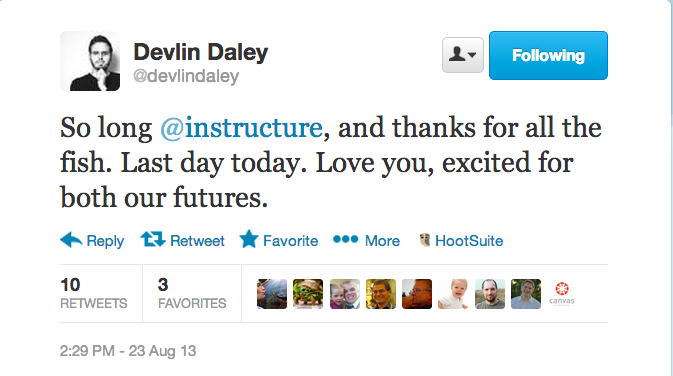Despite all the media hype on MOOCs over the past two years, perhaps the most important recent market entry for ed tech has been Canvas, the LMS from Instructure. Instructure was founded in 2008 by Brian Whitmer and Devlin Daley. At the time Brian and Devlin were graduate students at BYU who had just taken a class taught by Josh Coates, where their assignment was to come up with a product and business model to address a specific challenge. Brian and Devlin chose the LMS market based on the poor designs and older architectures dominating the market. This design led to the founding of Instructure, with Josh eventually providing seed funding and becoming CEO by 2010.
Michael covered the burst of news in January 2011 that served as the launch of Canvas.
Instructure has just announced that they will be releasing an open source version of their Canvas LMS product. Between this announcement, the winning of the Utah Education Network contract (109,000 college students and 40,000 K12 students), and the oh-so-ever-brief lawsuit by Desire2Learn about that win, Instructure has been making quite a splash lately.
Since that time Instructure has grown to 7M+ users, 500 customers and 240 employees while raising $50M in total VC funding. With that much early success, it was a surprise to see Devlin Daley leave the company as of last week with his Douglas Adams reference.
What does the departure of this co-founder mean to Instructure and its future path? For some perspective, it would help to understand the change in roles that occurred in early 2011.
From the founding of Instructure through the big release of Canvas in January 2011, Brian and Devlin shared tasks primarily based on their backgrounds – Brian’s in usability design and Devlin’s in architecture and software security, although their work overlapped as can be expected in any small team. They both led development of the product as well as business development based on our their specialties. They were heavily influenced with their BYU background by David Wiley, Jared Stein (now working for Instructure) and their visions of more open architectures and learning networks.
In early 2011, however, the company made a conscious decision to have Devlin hit the road as lead evangelist and sales closer while Brian stayed mostly in company headquarters leading usability design as well as the move to an LTI-based open platform. In other words they became an inside-outside team with Devlin was on the road for most of the past two years.
The official word on Devlin’s reason for departure is that he still has the entrepreneurial bug to find clever technology solutions, whereas Instructure is now a growing company with a maturing feature set. He has been talking to people and getting ideas, but some of these ideas don’t make sense in an established LMS product.
While that official explanation makes sense, it doesn’t mean that Devlin’s departure will not affect Instructure. The biggest challenge they will face, in my opinion, is having someone out on the road, working with customers, asking why and what if questions. Just naming a person or two to this role is not the same as having the original vision and skills from a co-founder, although I would expect Jared Stein to play a key role in this regard.
This transition comes at a critical time for Instructure. The growing number of customers acquired in late 2011 through 2012 are now entering or in production, and there is a growing demand for more and more features. The honeymoon is over and marriage requires hard work to last. System administrators tend to focus on the LMS power users and advanced feature requests when they work with vendors, often trying to mold the company’s products into what they are used to or how they would design the product themselves. Canvas was designed with simplicity in mind. In particular, most legacy LMSs have been designed with institutional control in mind – how do I prevent students from doing X, how do I allow students to do Y when Z occurs. Canvas focuses more on faculty and student control – how do I want to receive my communications, how do I bring in material from outside the LMS, how do I add apps at my control. This is not a trivial distinction, and maintaining the right balance requires listening to customers, asking deeper questions to understand needs, and also the ability to either say ‘no’ or present an alternative solution.
Higher education institutions will need to carefully evaluate if Instructure stays true to its founding values of simplicity and modern design while avoiding the trap of feature-bloat that has plagued the ed tech market. At the same time, there are missing features that customers need, as can be seen in the discussion forums such as this one on uploading content to multiple courses at once. This type of balance between feature requests and simplicity is the area for customers to watch to understand how well Instructure handles Devlin’s departure.
For their part, Instructure put together a party for Devlin last Friday and posted a YouTube video on the event.

[…] co-founders, announced on Twitter late last week that he’s left the company. Phil Hill has some thoughts about what the departure might mean to the […]